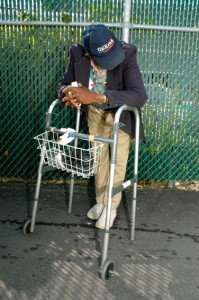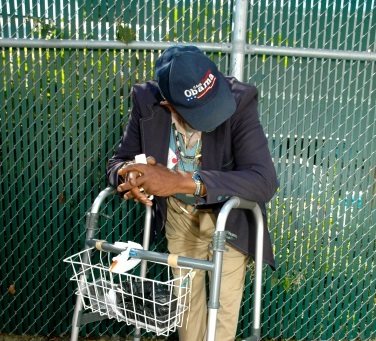By Kathy Kuhn, Center for Aging and Disability Resource (CADER), BU School of Social Work
 In my last blog post on mental health and aging, I described Ms. McKay, an older woman who was coping with multiple losses. She had significant hypertension, diabetes, and arthritis. She had been active in her church but was spending more and more time alone in her apartment and not even collecting her mail. Her closest relative had recently moved away. She felt that nobody really cared if she even showed up. Despite the clear signs of depression, Ms. McKay’s provider did not notice them during her last doctor’s visit.
In my last blog post on mental health and aging, I described Ms. McKay, an older woman who was coping with multiple losses. She had significant hypertension, diabetes, and arthritis. She had been active in her church but was spending more and more time alone in her apartment and not even collecting her mail. Her closest relative had recently moved away. She felt that nobody really cared if she even showed up. Despite the clear signs of depression, Ms. McKay’s provider did not notice them during her last doctor’s visit.
In many ways, Ms. McKay is typical of older adults with mental health concerns. The Massachusetts Healthy Aging Data Report found that 29 percent of Massachusetts residents 65 or older have shown signs and symptoms of depression and in some communities the rate is closer to 40 percent. Many older adults think that depression is a normal part of aging. The feeling of “needing to get over it” comes with both shame and isolation. This can be an opportunity for providers to intervene.
Recognize the Red Flags
Those familiar with the signs, symptoms, resources and interventions will find several red flags that can either be addressed or ignored.
- Changes in Physical Health Can Affect Mental Health. Many older adults with mental health concerns also have physical health conditions and functional impairments that can complicate the detection and treatment of both the physical condition as well as the mental health concern. It is important in situations like Ms. McKay’s to understand the effect of her hypertension, diabetes, and arthritis on her mental health. Reviewing medication and function as well as addressing both physical and mental health concerns will lead to a better outcome.
- Social Isolation. Social relationships can have a significant impact on physical health. Research has found a 50 percent increase in survival of people with robust social relationships. Ms. McKay had stopped her social activities, including attending church, socializing in the lobby of her building and even collecting her mail. Asking a simple question such as, “Do you have someone you can confide in or talk to about things that are important to you?” can alert us to the possibility of social isolation. As a society, it is vital that we begin to actively reach out to our community, neighbors, and friends. With Ms. McKay, the resident service coordinator in her building persisted in finding resources for Ms. McKay. She agreed to talk to a social worker in her home, who was able to address her depression and assisted in reconnecting her to social supports.
- Feeling Down/Loss of Interest. Most older adults have primary care providers who they see regularly. Screening for depression can be an important step in getting help. By using tools like the Patient Health Questionaire-2 (PHQ-2) that asks two questions, the rate for identification of depression significantly increases. The two questions are (a) ‘during the past weeks have you often been bothered by feeling down, depressed, or hopeless?’ and (b) ‘during the past month have you often been bothered by little interest or pleasure in doing things.’ Screening can be a first step in getting help.
Engage from a Strengths-Based Perspective
When there are red flags, one of the most important things is to engage in a conversation that is non-judgmental, non-confrontational and collaborative. Many of us, including older adults, are fearful about sharing our true feelings. Older adults fear consequences such as loss of independence, choice and others making decisions for them.
It is imperative to approach the person from a strengths-based perspective. Ms. McKay needs to know that she is recognized for more than her sadnessor her losses. Although these are a part of her, we also focused on her strength, her value, her ability to change, and her resilience. The way she is spoken to about our concerns will also affect her willingness to talk freely. Additionally it would be important to:
- Talk in a private setting
- Listen
- Be non-judgmental
- Identify strengths
- Point out specific observations that you have noticed
- Ask the person how they see the concern
- Ask how they think the concern could be solved
- Convey your experience that behavioral health concerns respond to treatment
- Express concern, caring, and a belief that no one should suffer needlessly
- Hold out hope
- Make suggestions and elicit response
- Offer a menu of options
Utilize Resources
Throughout Massachusetts, best practices in mental health for older adults do exist. Several evidence based programs such as Healthy IDEAS and Gatekeeper Training are being utilized. Evidence-based therapeutic interventions such as cognitive behavioral therapy, interpersonal therapy, and problem solving therapy are part of many mental health organizations’ treatment programs.
There are several organizations that can help. The Massachusetts Department of Health has a Suicide Prevention Program that offers resources for older adults and mental health. Across the Commonwealth, every region has an Aging & Disability Resource Centers (ADRC). This serves as an entryway to all services, and part of a new No Wrong Door system of care. There is also the Association for Behavioral Health Care, which can provide further information about mental health resources. The Center for Aging and Disability Education and Training (CADER) also offers an online training program for health and social service practitioners to learn how to work with older adults.
This issue is just too important to ignore. At times it feels like an uphill battle, but together I believe health and social service providers, family, and friends can make a difference.
Is mental health among older adults an important part of your work? What programs or approaches have you found to be the most successful? What do you want to see happening in the future in this field? Please share your comments below.

